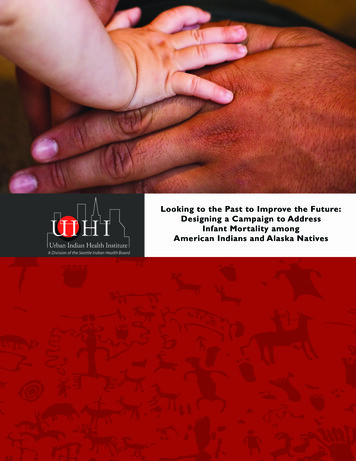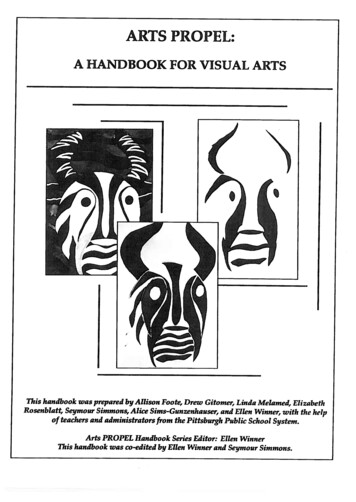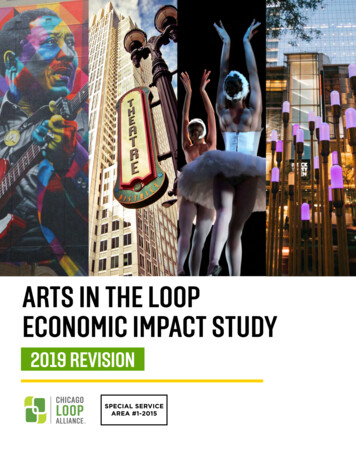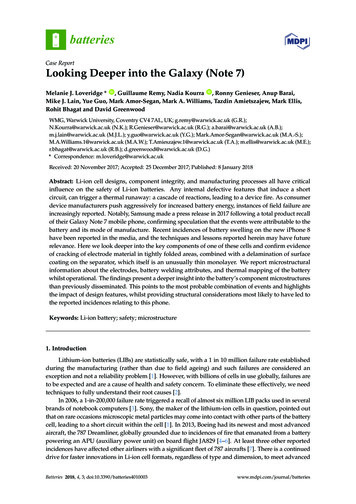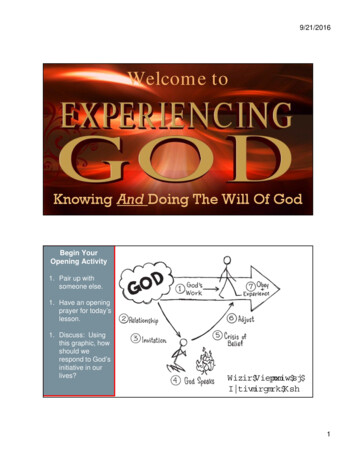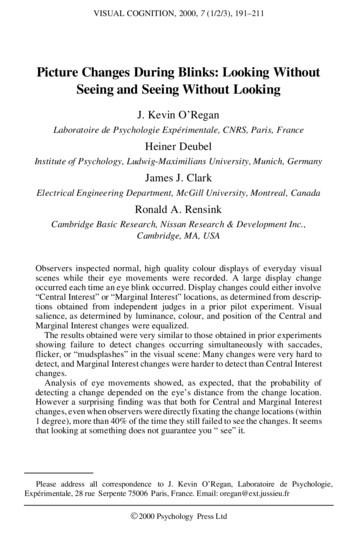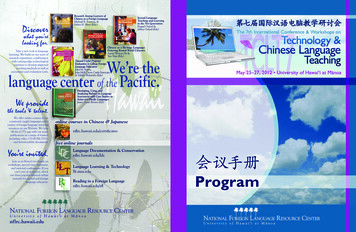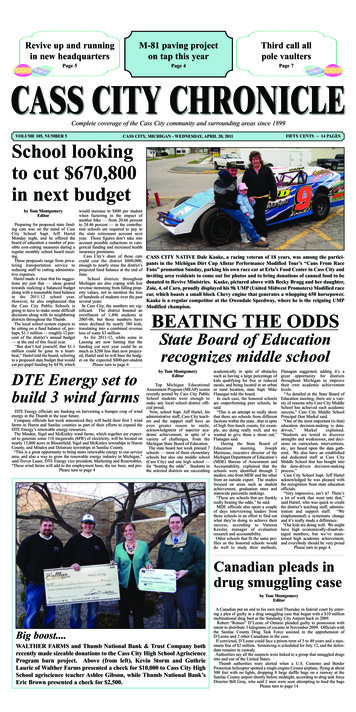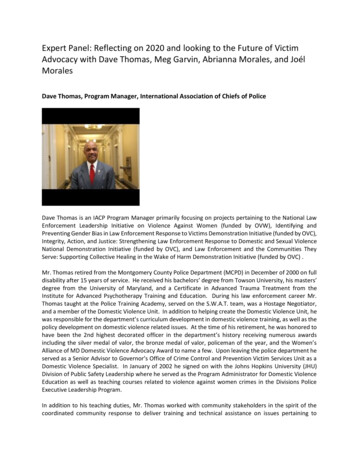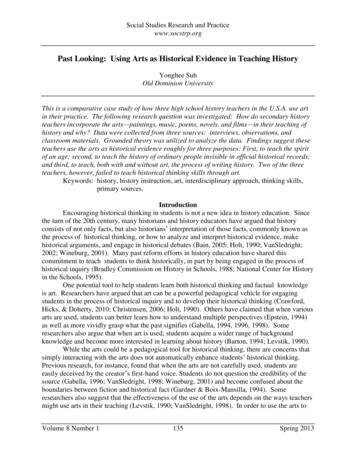
Transcription
Social Studies Research and Practicewww.socstrp.orgPast Looking: Using Arts as Historical Evidence in Teaching HistoryYonghee SuhOld Dominion UniversityThis is a comparative case study of how three high school history teachers in the U.S.A. use artin their practice. The following research question was investigated: How do secondary historyteachers incorporate the arts—paintings, music, poems, novels, and films—in their teaching ofhistory and why? Data were collected from three sources: interviews, observations, andclassroom materials. Grounded theory was utilized to analyze the data. Findings suggest theseteachers use the arts as historical evidence roughly for three purposes: First, to teach the spiritof an age; second, to teach the history of ordinary people invisible in official historical records;and third, to teach, both with and without art, the process of writing history. Two of the threeteachers, however, failed to teach historical thinking skills through art.Keywords: history, history instruction, art, interdisciplinary approach, thinking skills,primary sources.IntroductionEncouraging historical thinking in students is not a new idea in history education. Sincethe turn of the 20th century, many historians and history educators have argued that historyconsists of not only facts, but also historians’ interpretation of those facts, commonly known asthe process of historical thinking, or how to analyze and interpret historical evidence, makehistorical arguments, and engage in historical debates (Bain, 2005; Holt, 1990; VanSledright;2002; Wineburg, 2001). Many past reform efforts in history education have shared thiscommitment to teach students to think historically, in part by being engaged in the process ofhistorical inquiry (Bradley Commission on History in Schools, 1988; National Center for Historyin the Schools, 1995).One potential tool to help students learn both historical thinking and factual knowledgeis art. Researchers have argued that art can be a powerful pedagogical vehicle for engagingstudents in the process of historical inquiry and to develop their historical thinking (Crawford,Hicks, & Doherty, 2010; Christensen, 2006; Holt, 1990). Others have claimed that when variousarts are used, students can better learn how to understand multiple perspectives (Epstein, 1994)as well as more vividly grasp what the past signifies (Gabella, 1994, 1996, 1998). Someresearchers also argue that when art is used, students acquire a wider range of backgroundknowledge and become more interested in learning about history (Barton, 1994; Levstik, 1990).While the arts could be a pedagogical tool for historical thinking, there are concerns thatsimply interacting with the arts does not automatically enhance students’ historical thinking.Previous research, for instance, found that when the arts are not carefully used, students areeasily deceived by the creator’s first-hand voice. Students do not question the credibility of thesource (Gabella, 1996; VanSledright, 1998; Wineburg, 2001) and become confused about theboundaries between fiction and historical fact (Gardner & Boix-Mansilla, 1994). Someresearchers also suggest that the effectiveness of the use of the arts depends on the ways teachersmight use arts in their teaching (Levstik, 1990; VanSledright, 1998). In order to use the arts toVolume 8 Number 1135Spring 2013
Social Studies Research and Practicewww.socstrp.orgpromote students’ historical thinking, teachers should be more thoughtful about how they use artto teach history: what artwork they use, when, and how. Most previous research on this subjecthas focused on the student side of learning through the arts rather than the pedagogical reasoningand methods teachers employ to incorporate art into their teaching, asking questions such as: Forwhat purposes do history teachers choose to service the arts in teaching history? To accomplishthose purposes, how do such teachers utilize the arts? What kinds of arts do they select to use?What are the constraints that limit the teachers’ incorporation of the arts into their practice?Responding to these questions, this study explores the gap in research and describes the waythree high school history teachers’ use art in their practice and seeks to explain the pedagogicaldecisions behind their use of art in the classroom.Theoretical FrameworkThis study draws its theoretical framework largely from three lines of research: scholarshipof art, scholarship of history, and research on teaching history through arts. The first and secondlines of research suggest the common ground between art and history, and offer a lens throughwhich to view how history teachers use art and what features of art allow historians and historyteachers to use art in their practice. The third line of research identifies the potential roles of thearts in enhancing students’ historical thinking, and provides rationales for the focus on the use ofthe arts in this study.Defining ArtThis study defines the term “art” (also the terms “arts,” “the arts,” and “artwork”)broadly. There have been three major scholarly approaches to defining art. The first focuses onthe “art object” itself, for example, a painting or sculpture. Both ancient and contemporary artphilosophers argue that art as art object represents the physical and mental world of humanbeings that is not only personal but also associated with society in general (Bell, 1914/1930;Dewey, 1934; Dickie, 1971; Langer, 1953; Levinson, 1998). The second approach focuses onthe process of creating artwork. In other words, while the first approach emphasizes the productof artistic creation, the second emphasizes both the creative process and the artist who createdthe artwork. Artists such as Percy Bysshe Shelley (1900) and Leo Tolstoy (1897) considered artthe process of creating art objects (e.g., writing poems or writing novels) and both pointed outone of the critical features of art is that artists express their personal emotions through art so thatthe emotions themselves aid in the creation of, and become a part of, the art object. Morerecently, philosophers of art have provided a third definition of art, which attends to the aestheticexperience, or the quality of experience art objects create. Maxine Greene (1991), for instance,discusses the meanings art evokes through aesthetic experience. She argues that when peoplehear and see artwork, they do not passively accept what the artist expresses through the artwork.Since it is often difficult to glean the significance of an artwork without proper training orguidance, the audience has to either actively participate in understanding the meanings of theartwork or create their own meanings. Given the three approaches to defining art, this study doesnot use any one specific definition of art. Instead, it uses the terms “art” and “the arts”interchangeably, and adheres to the following comprehensive definition of “the arts” offered bythe U.S. Congress. This definition also aids in outlining the prevalent notions of art incontemporary society:Volume 8 Number 1136Spring 2013
Social Studies Research and Practicewww.socstrp.orgThe term “the arts” includes, but is not limited to, music (instrumental and vocal), dance,drama, folk art, creative writing, architecture and allied fields, painting, sculpture,photography, graphic and craft arts, industrial design, costume and fashion design,motion pictures, television, radio, film, video, tape and sound recording, the arts relatedto the presentation, performance, execution, and exhibition of such major art forms, allthose traditional arts practiced by the diverse peoples of this country, (sic) and the studyand application of the arts to the human environment (the National Endowment for theArts and the National Endowment for the Humanities, 1965).Using Art in the Discipline of HistorySimilar to art philosophers who define art as “art object,” historians have used art asevidence to learn about the physical and mental worlds of the past. Peter Burke (1991) notes thatonly during the last three decades have historians broadened their interests to include not onlythe history of political events, economic trends, and social structures, but also the history ofculture, everyday life, and ordinary people. This increasing curiosity about cultural and socialhistory has drawn historians’ eyes to a kind of historical source that they have not traditionallyturned to, art. Historians argue that modern advances in technology allow scholars and studentsof history to access art more easily than before through the Internet and multimedia-basedarchives.Cultural historians, such as Jacob Burckhardt, Johan Huizinga, Phillip Aries, and SimonSchama, have used art as evidence to learn about the culture and mentalities of people in thepast. Burckhardt (1840/1995) and Huizinga (1919/1996) identified the characteristics—respectively—of the Italian and Dutch Renaissances by examining visual arts and literature ascritical sources. Images of children and adolescents in paintings and literature were reviewed toexplore how the modern concept of childhood emerged in sixteenth and seventeenth centuryFrance (Aries, 1962). More than three hundred paintings were investigated as sources toillustrate what Dutch affluence looked like and how moral sensibilities and patriotism shapedDutch behaviors in everyday life (Schama, 1987).Social historians have used art to learn about the culture of socially invisible people(often women or other marginalized groups), many of whom were illiterate and, therefore, not aswell-represented in written and recorded artifacts (Bravati, Buxton, & Seldon, 1996; Burke,1991). Robert W. Scribner (1981/1994), a historian of the German Reformation, for instance,used the visual propaganda found in woodcuts and book illustrations as the main source for hisargument in For the Sake of Simple Folk: Popular Propaganda for the German Reformation.Scribner maintained that, because most lower class Germans were illiterate (only five percent ofGermans were literate in the 16th century), visual propaganda was important for both antireformists and reformists in spreading evangelical messages. Thus, he posited that analyzingvisual propaganda would be the most helpful way to examine the beliefs and values antireformists and reformists wanted to communicate to the illiterate masses, and to understand themessages to which lower class Germans were exposed.While cultural and social historians have used art as historical evidence, there is a groupof philosophers of history, literary critics, and historians who focus on the process of writinghistory and claim that history is art, specifically the art of fiction (Barthes, 1970; La Capra,1983; White, 1973). Focusing on the process of creating historical accounts and the imaginationthat such works require, they maintain there is no essential difference between history and fictionVolume 8 Number 1137Spring 2013
Social Studies Research and Practicewww.socstrp.organd that, although historians are assumed to objectively document past events, they can neverformulate truly objective accounts. Some historians and literary critics, thus, claim that history is“a story about the past that historians create by their imagination” (Jenkins, 1991, p. 26), ratherthan a record of what really happened.In sum, there appears to be a loose correlation between the three definitions of art, thedifferent schools of historical scholarship, and how various historians use art. A caveat is inorder here. Although the loose associations between the various definitions of art and thevarious schools of historical thought have been pointed out, ideas about art and its use in historyare much more fluid when considered by historians and philosophers of art and history. Muchlike John Dewey (1934), who pulled together very different ideas under the umbrella of art,historians can conceptualize and use art in a variety of ways, making it nearly impossible to putthem in a single cell of any such analysis. This is suggestive of how art and history conmingle.Using Art in Teaching HistoryContemporary philosophers of art have become interested in the kind of experiencesartwork can evoke. In a similar fashion, education researchers have recently begun to explorewhat learning experiences art can generate in history classrooms, especially when particularworks of art are presented as historical evidence. Some researchers contend that art is a uniquepedagogical tool helping students construct a historical understanding of the past, in a way thatother sources cannot (Barton, 2001; Epstein, 1994a, b; Gabella, 1994, 1996, 1998; Levstik &Barton, 2001/2005). In a study of her own eleventh grade U.S. history class, Terrie Epstein(1994b), for instance, found that when various arts were used, students developed knowledgethat is “human or lifelike” in form, unlike the analytical knowledge that they gain from historytextbooks or other non-art sources. She also reported that when art is used as an evaluative toolto measure students’ historical understanding, students who felt uncomfortable expressing theirideas in writing performed better (Epstein, 1994a). Marcy Singer-Gabella (1994, 1996) studiedan eleventh grade U.S. history class where works of art, such as photography, film, painting, andmusic, were used as main teaching resources. The study argues that because art is an expressionof human experience, it allows students to acquire a type of historical understanding easilyaccommodating various perspectives and fosters a degree of empathy for historical actors.While the first group of researchers highlights the unique features of art as a pedagogicaltool, another group of researchers, including historians and history educators, is considering artas historical evidence that can advance students’ historical thinking just as is done by otherprimary documents. A group of historians published a series of articles in a special issue ofJournal of American History (Coventry et al., 2006), reporting their experiences in using worksof art to teach students. They argued that learning about the past through art requires bothteachers and students to be equipped with the intellectual thinking skills they would need whenworking with other primary sources. History educators confirm this argument and further definehistorical thinking as the ability to place a piece of artwork in a larger historical context, and tomake an argument about the artwork’s place in a particular time period, just as historians dowhen they inquire about the past by using works of art as historical evidence (Barton, 2001;Desai, Hamlin, & Mattson, 2010).Despite these arguments for the potential role of art to develop students’ historicalunderstanding, empirical studies on how art is actually incorporated into history classrooms arescarce. The recent existing body of research focuses on a couple of specific genres of art, suchVolume 8 Number 1138Spring 2013
Social Studies Research and Practicewww.socstrp.orgas photography (Barton, 2001; Foster, Hoge, & Rosch, 1999; Marcus & Levine, 2011; Seixas,1998) and film (Marcus, 2006; Marcus, Metzger, Paxton, & Stoddard, 2010; Metzger & Suh,2008). Other similar studies focus on the students’ side only, asking questions such as what andhow students learn history through the arts (Epstein, 1994a, 1994b, 1996; Gabella, 1994, 1996,1998). Less is known about how history teachers incorporate arts in their practice: what specificartwork and which instructional strategies teachers choose to use, and why. Such scarcity ofresearch necessitates this empirical study of three high school history teachers and their use ofthe arts in the classroom.MethodThis is a comparative case study (Yin, 2003) of three experienced high school historyteachers that aims to produce thick description (Geertz, 1973) of the teachers’ use of the arts intheir teaching. A chain sampling strategy was used to find teachers for this study (Maxwell,1996; Patton, 2002; Weiss, 1994), which means that the author was introduced to these teachersthrough faculty members, colleagues, and friends. The author was introduced to Sharon througha colleague at the graduate school for the reputation of her school’s interdisciplinary program.The author met Brandon through a faculty member in the college of education, who was workingwith Brandon on an independent study in the Master’s degree program. Lastly, the authorobserved Tom and his student teacher, whom she supervised, using arts as they co-taught in theclassroom. Because art is so seldom used as a critical tool in teaching history, the pool ofpotential teachers was small; therefore, the sample is largely a convenience sample. These threeteachers were selected for the study because they were willing to participate in the study andused art in some way in a U.S. public high school. All three teachers—Sharon, Brandon, andTom—are European Americans and have taught for more than ten years. All three incorporateart, such as fine arts, popular arts, music, and literature, into their classrooms. Brandon and Tomwork in schools in small, suburban, Midwestern cities, while Sharon teaches in a researchuniversity town. In all the representative schools, more than 70% of the student population wasEuropean American. These teachers’ classes were regular classes. A more detailed descriptionof the participants will follow in the findings section.Data were collected from three sources. First, two interviews, the “knowledge andbeliefs interviews,” were conducted. The goal of the first interview was to learn what eachteacher knows about the topics in his or her unit. The second interview was conducted to learnwhat each teacher knew about the artwork he or she uses (e.g., who created it, when, and why)and why he or she believes using the artwork is helpful for teaching the topic. Interviews wererecorded and transcribed by the researcher. Second, six observations of each teacher’s lessonsand three post-observation interviews were conducted. Each class was tape-recorded and fieldnotes were taken during the observation. Interviews were recorded and transcribed by theresearcher. The focus of the observations was the artworks used, the topics taught with theartwork, and the instructional strategies employed in using the arts. The post-observationinterviews were used to learn what particular artwork the teachers use in order to teach eachparticular topic, and why. Third, teaching materials (i.e. handouts, textbook passages,assignments, etc.) were collected to complement data from interviews and class observations.Sharon’s Renaissance unit, Brandon’s 1920s unit, and Tom’s unit about the AmericanVolume 8 Number 1139Spring 2013
Social Studies Research and Practicewww.socstrp.orgRevolution were selected for observation because the three teachers said they most frequentlyuse the arts for these units and felt most comfortable being observed teaching the identified unit.All data were analyzed using the constant comparative method (Glaser & Strauss, 1967).The data analysis process consisted of three stages. The first stage involved writing memos andcoding data while collecting them. New coding categories emerged as the data were beinganalyzed. An initial set of coding categories came from the research questions (Miles &Huberman, 1994) and included categories such as the teachers’ definitions of art, their purposesfor using art in teaching history, the content taught by the teachers through art, instructionalstrategies employed by the teachers in using art, and factors that affect their ways of using art.The second stage included writing a single case for each teacher, and then comparing the threecases, along with linking data with theories in the disciplines of history and history education.Writing and comparing cases enabled the recognition of the similarities and differences betweenthe three teachers and their uses of art. Literature in the discipl
teachers incorporate the arts—paintings, music, poems, novels, and films—in their teaching of history and why? Data were collected from three sources: interviews, observations, and classroom materials. Grounded theory was utilized to
